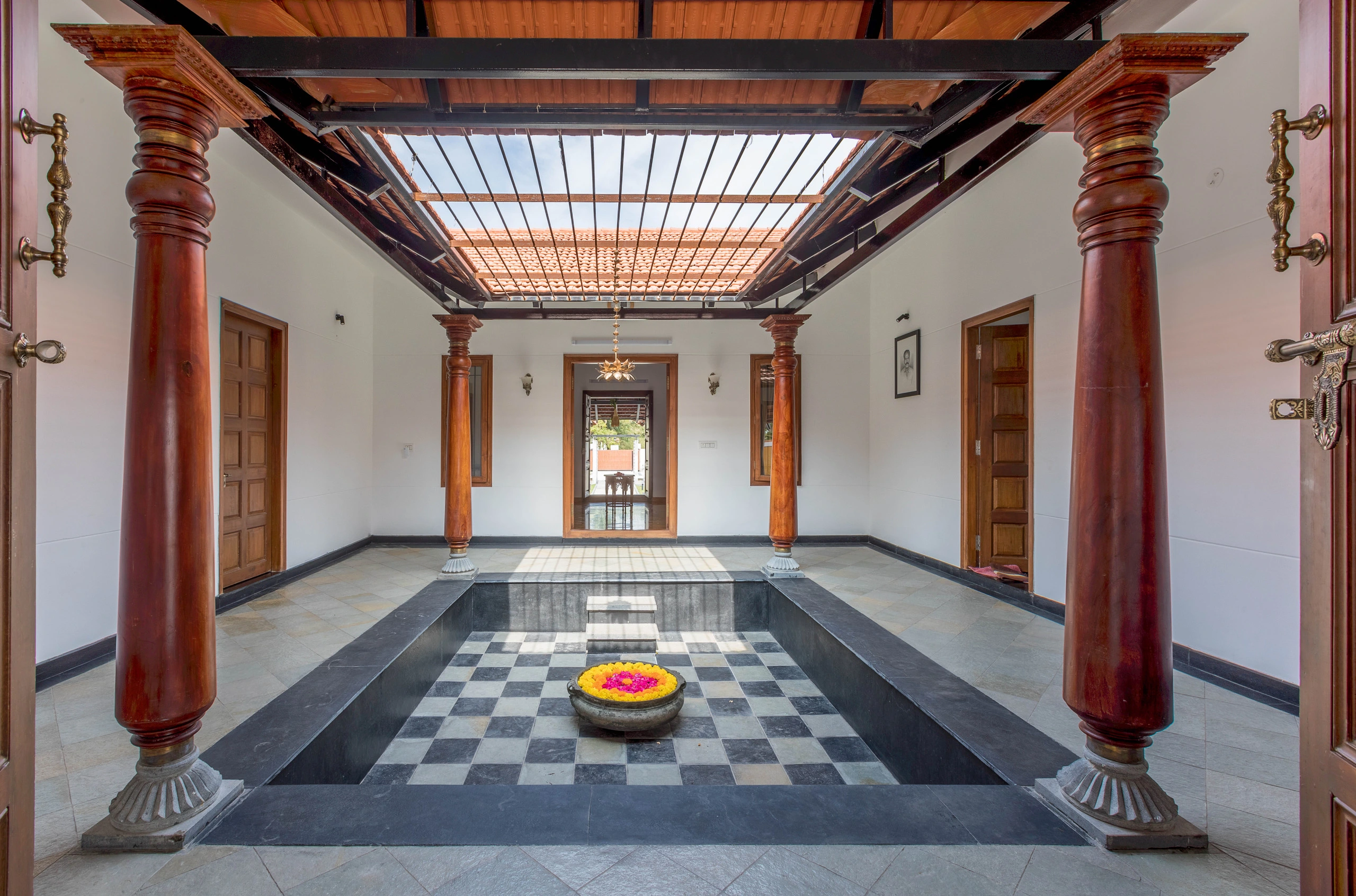Tamil Nadu’s legacy is deeply rooted in temple architecture, royal Chettinad homes, classical art, traditional crafts, and vibrant textiles. Interior design inspired by this heritage reflects elegance, warmth, craftsmanship, and spiritual richness — all while maintaining timeless beauty.
1. Architectural Influence: Chettinad Style
The grand homes of the Chettinad region in Tamil Nadu are iconic for their architectural brilliance.
Key Features:
-
Courtyards (Mutram): Open-to-sky central courtyards allow natural light and ventilation.
-
Thinnai: Raised seating platforms at the entrance of traditional homes.
-
High Ceilings & Wooden Beams: Help keep the space cool and airy.
-
Ornate Columns & Arches: Inspired by temple architecture and colonial influence.
Modern Tip: You can adapt this style in urban homes by integrating small courtyards or sun-lit atriums, wooden pillars, or traditional verandahs.
Also read: Top kitchen cabinet color idea for 2025
2. Traditional Materials & Finishes
Materials That Reflect Tamil Craftsmanship:
-
Athangudi Tiles: Handcrafted in vibrant geometric or floral designs. Used for flooring and feature walls.
-
Terracotta & Clay: For decorative items, wall tiles, and lamps.
-
Wood (Teak, Rosewood): Used in furniture, doors, ceilings, and carved elements.
-
Brass & Bronze: In temple lamps (kuthu vilakku), urlis, bells, and statues.
These materials add warmth and history to any interior.
Also read
3. Art & Decor Elements
Tamil Nadu–Inspired Décor:
-
Tanjore Paintings: Famous for their rich colors, gold foil, and religious themes.
-
Thanjavur Dolls: Displayed in niches or showcases.
-
Bronze Sculptures: Especially of Nataraja, Ganesha, and other deities.
-
Kolam Designs: Used as wall art or even floor tile patterns.
Modern Tip: Place a single Tanjore painting in a minimalist space for a powerful focal point.
4. Furniture & Layout
Signature Pieces:
-
Carved Wooden Swings (Oonjal): Often suspended in the living room or porch.
-
Low Wooden Cots (Manai): Used traditionally for seating or sleeping.
-
Teak Cabinets & Sideboards: With brass or antique handles.
The layout is often centered around family gatherings, with an open central space surrounded by rooms.
5. Spiritual & Cultural Symbols
Tamil Nadu's heritage is deeply spiritual. A heritage-style home often includes:
-
Dedicated Pooja Room: With stone or wooden altar, brass lamps, and sacred bells.
-
Temple Bells, Diyas, Oil Lamps: Used as functional decor.
-
Sanskrit or Tamil Inscriptions: As wall hangings or carvings.
This adds a sense of peace and rootedness to the home.
6. Textiles & Color Schemes
Fabrics:
-
Kanchipuram Silk & Sungudi Cotton: Used for curtains, cushions, or upholstery.
-
Block-Printed or Handwoven Fabrics: Ideal for table runners, wall hangings, etc.
Color Palette:
-
Earth Tones: Terracotta, mustard, deep reds, browns, and gold.
-
Accent Colors: Indigo blue, temple gray, forest green.
-
Finish: Matte textures, hand-painted murals, or carved wooden panels.
7. How to Blend Heritage with Modern Living
Modern Tamil-inspired homes often balance functionality and tradition:
| Modern Element | Heritage Adaptation |
|---|---|
| Open Floor Plan | Add a central mutram or small indoor garden |
| Modular Kitchen | Use Athangudi tiles or brass handles for cabinets |
| Minimalist Decor | One bold Tanjore painting or carved wooden door frame |
| Concrete or tile floors | Add woven rugs or kolam-inspired tiles for warmth |
Interior design inspired by Tamil Nadu’s heritage is not just about aesthetics — it’s a celebration of cultural identity, craftsmanship, and timeless elegance. Whether it’s a large villa or a modern apartment, you can incorporate:
-
Handcrafted materials
-
Classical artwork
-
Traditional furniture
-
Spiritual decor
https://www.livehomes.in/blogs













